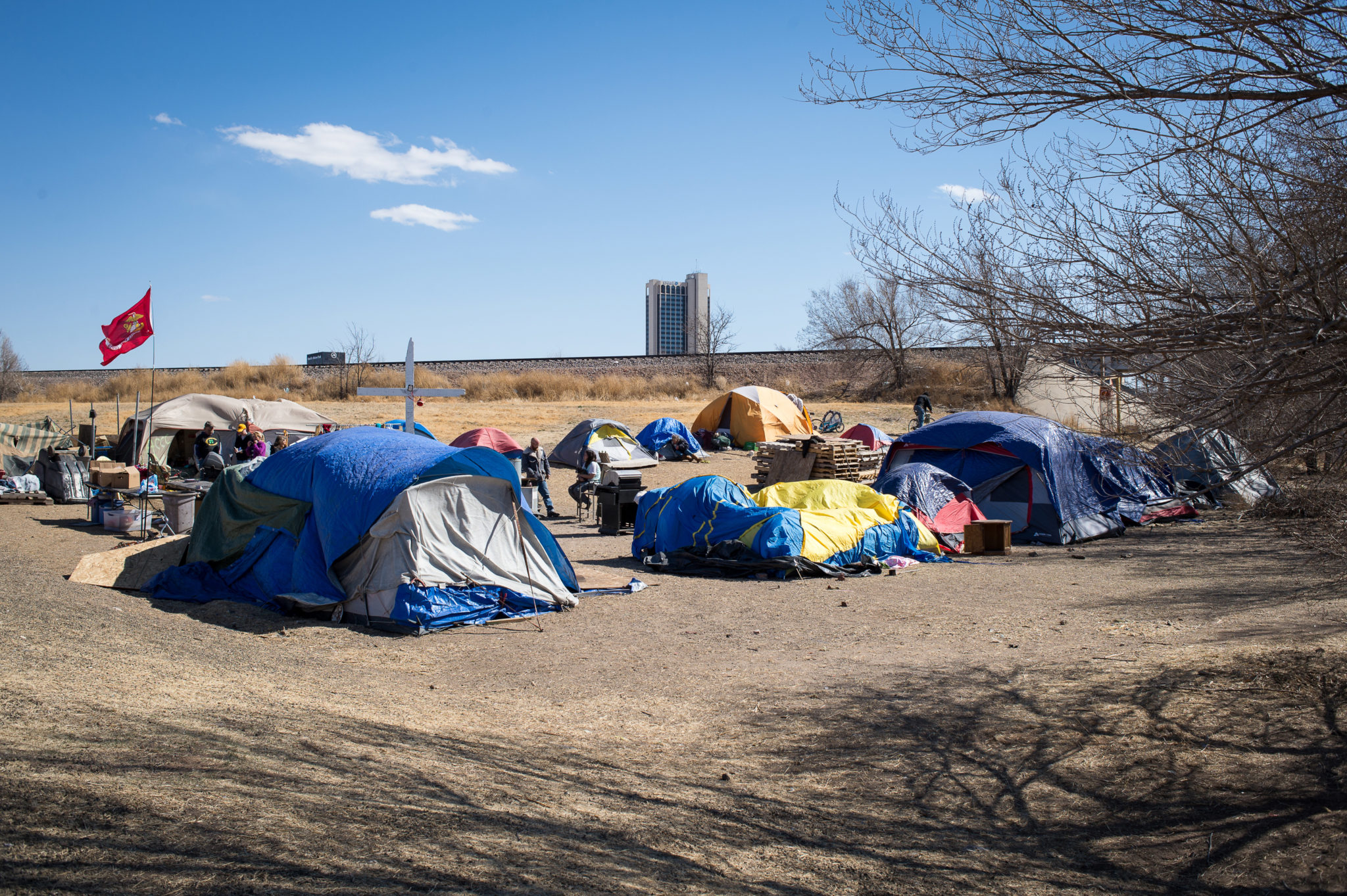Hope (and Possible Heartbreak) at Amarillo’s ‘Tent City’
Advocates for the homeless in Amarillo have cheered the creation of a “tent city” near downtown, but the site has raised the ire of city officials threatening fines.
Though they’re not related, Brian Allan Moore and Nicholas Rocha refer to each other as brothers. The men grew up in the same Oklahoma City suburb of Del City and have had similar struggles with homelessness and methamphetamine addiction. “Del City: Come on vacation, leave on probation,” says 28-year-old Rocha, a former bull rider who cycled through juvenile and adult lockups. On January 18, after months roaming through Oklahoma with a shopping cart full of their belongings, Moore and Rocha landed in Amarillo, where they were offered a space to stay at the Christ Church Camp of New Beginnings.
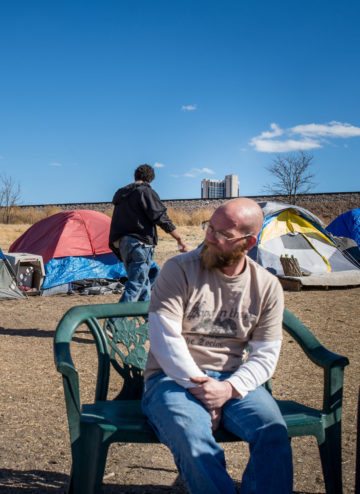
Some of the roughly 30 people who live here refer to Christ Church Camp as “tent city” — the site, set on a low berm between an underpass and a defunct railroad line just northwest of downtown, is a collection of faded tents encircling a fire pit and a 15-foot white cross.
On Sunday, Rocha invites me inside the tent he and Moore share. It’s not tall enough to stand in, but they have mattresses and blankets — overnight low temperatures dropped into the 20s this week — and an armoire stacked with trinkets. “Check this out,” says Rocha, as he flicks on a string of blue Christmas lights attached to the tent’s roof. Moore, who appears to always be in good spirits, sticks his head through the nylon door. “Welcome to MTV’s Cribs!” he says.
Since November, the camp has played host to a revolving cast of Amarillo’s growing homeless population. The site attracts those who do not fit into the city’s traditional shelters, which house about 550 people from the city, surrounding rural areas and other states. Some lack required identification or have been banned from shelters for fighting or being intoxicated. Others are unwilling to part with their belongings or pets. Some residents are couples who are loathe to split ways, as shelters generally house men and women separately. Compared to living on the streets, Christ Church Camp is a “blessing,” Moore said.
But now the camp, the brainchild of local homeless advocate Amanda Brown-Hunter, is at the center of an escalating dust-up between city officials and advocates who say the city’s draconian ordinances essentially punish homelessness. For example, sleeping on public property and living in a vehicle is prohibited. Offenders can be fined, and interactions with police sometimes lead to homeless people being run for warrants and being arrested for small-time drug possession or public intoxication.

Brown-Hunter said she assumed she was breaking no city rules when she opened the camp on leased private property, but city officials have dogged her about bathrooms, hygiene and trash. After addressing officials’ initial concerns, Brown-Hunter said the city dug up an ordinance forbidding camping on private property for longer than 72 hours at a time. Officials have put the camp on notice: If they don’t disband by Thursday, Brown-Hunter and the landowner face fines of $2,000 a day.
“We’ve bent over backwards to comply but they just won’t budge,” Brown-Hunter said. “Most of the ones in my camp don’t have another place to go.”
Assistant City Manager Kevin Starbuck said that the ordinance, which prohibits living in a temporary structure for more than three days, has been invoked for residents’ own good. “The use of temporary structures is not appropriate and there should be policies in place to get those individuals into shelter systems,” he said. “I know one of the criticisms is that the city went out and found this ordinance from 30 years ago. Maybe it was a misstep on the city’s part not to identify that at the time we became aware of the camp, but once we’ve been made aware of that through research our staff has done, we can’t turn our backs on it now.”
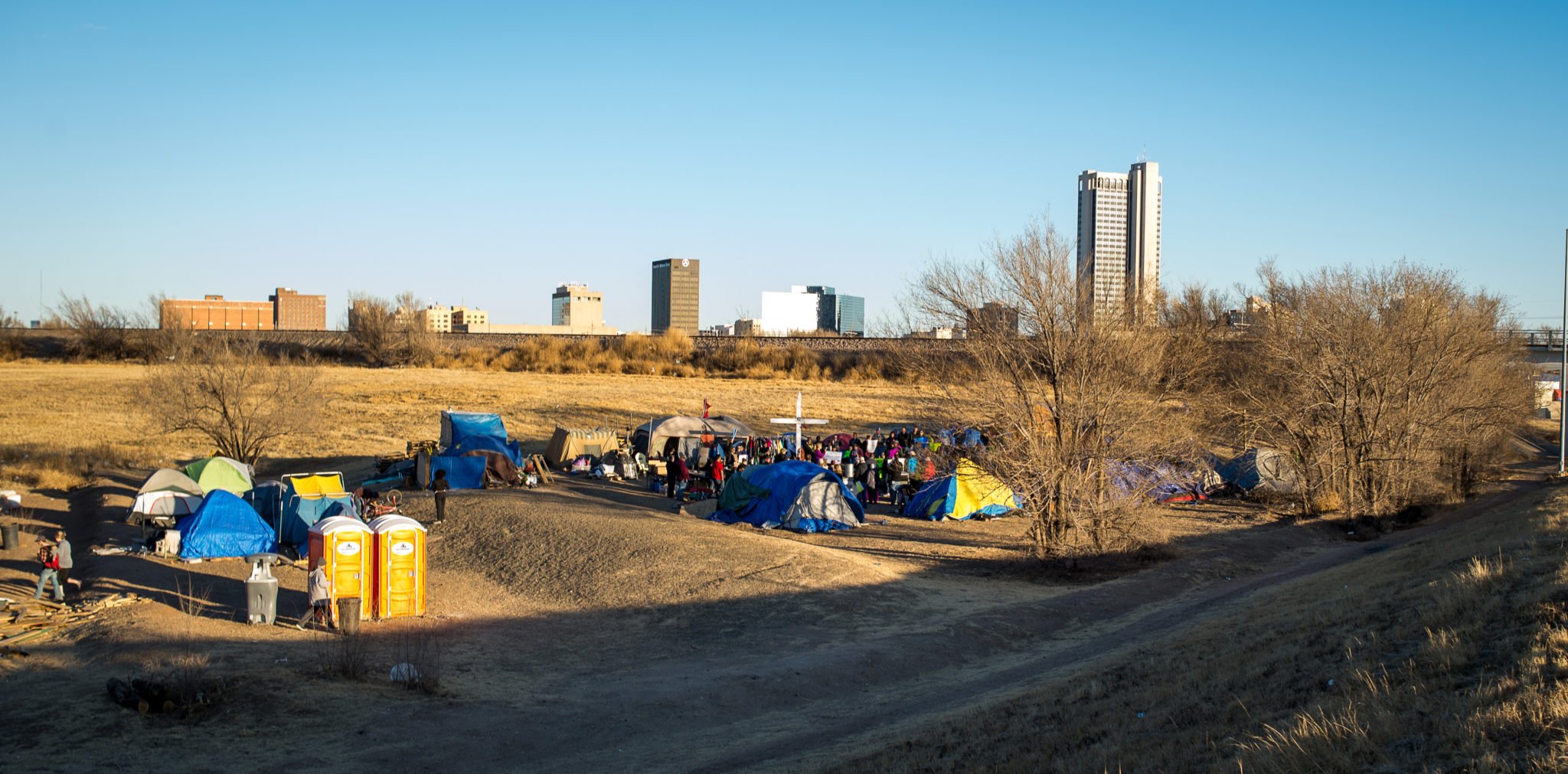
Advocates say that rules such as those being enforced in Amarillo are part of a criminal justice system that turns homeless people into petty criminals. In 2016, the National Law Center on Homelessness and Poverty surveyed 118 U.S. cities, finding that 33 percent of them prohibit camping in public and 18 percent prohibit sleeping in public citywide. Almost half ban sitting or lying down in public and 39 percent prohibit living in a vehicle.
In Dallas, which had its own high-profile eradication of a “tent city” last year, it’s illegal to “doze” in a park, alley or other public place. In San Antonio, you can’t use a car for “living accommodation.” Houston forbids sleeping in a makeshift structure on public property. “With no ability to abstain from basic human conduct, and with no private place to perform actions like sitting down or falling asleep, homeless people across the country are set up to violate laws prohibiting such conduct in public places,” the authors of the report wrote.
Like Brown-Hunter, those who try to help the homeless can end up in hot water, too — in 2015, a San Antonio chef who whipped up meals for the homeless was hit with a $2,000 fine.
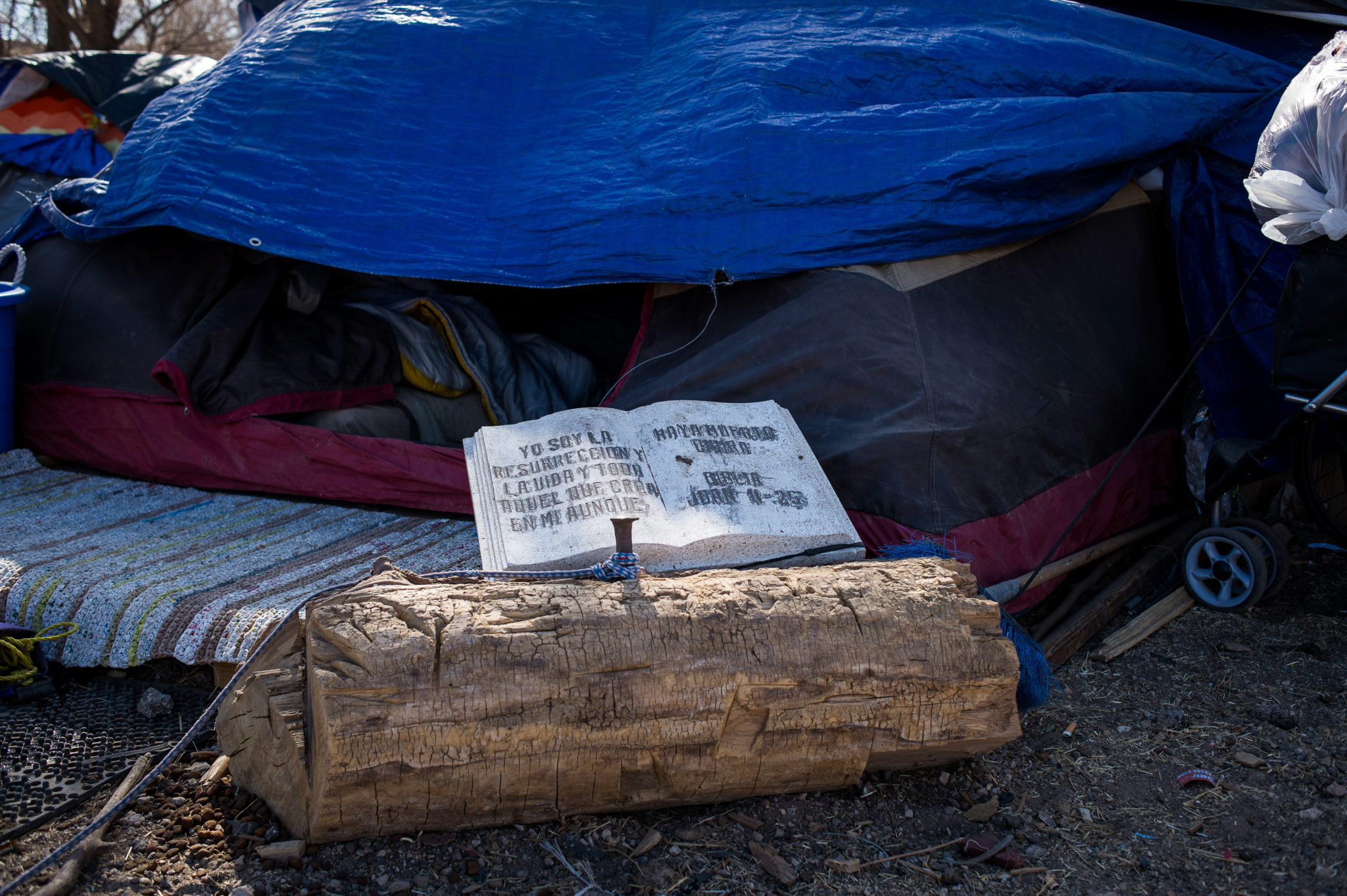
Texas has an estimated homeless population of 23,000. In Amarillo, advocates say “point in time” counts lowball the number of homeless at 675 (which represents an increase from the 2014 figure of 451). One nonprofit, Amarillo Housing First, puts the number between 1,100 and 1,800, more than double the available shelter beds.
“Ultimately, we can never arrest or fine our way out of this issue,” said Eric Samuels, president and CEO of the Texas Homeless Network. “The only way that we can effectively address homelessness is through a coordinated, community-based collaborative approach.” Not speaking specifically of Amarillo, Samuels suggested that cities create alternative penalties for homeless “nuisance” crimes along with increasing affordable housing and connecting the homeless with social services.
Brown-Hunter said her camp has been at least marginally successful — two of the residents have gone into drug treatment programs and another has sought out mental health treatment. If nothing else, the camp has given the people who live there a sense of community they didn’t have before, she said. That community stands to be broken up if the city follows through on its threat to refer violation notices to a district court. “For some of them it’s the only family they have,” she said. “They’re already starting to scatter because they know the city is coming.”
On Sunday, for the second week in a row, advocates, church groups and some of the camp’s residents prepared to march through downtown Amarillo in protest of the city’s actions.
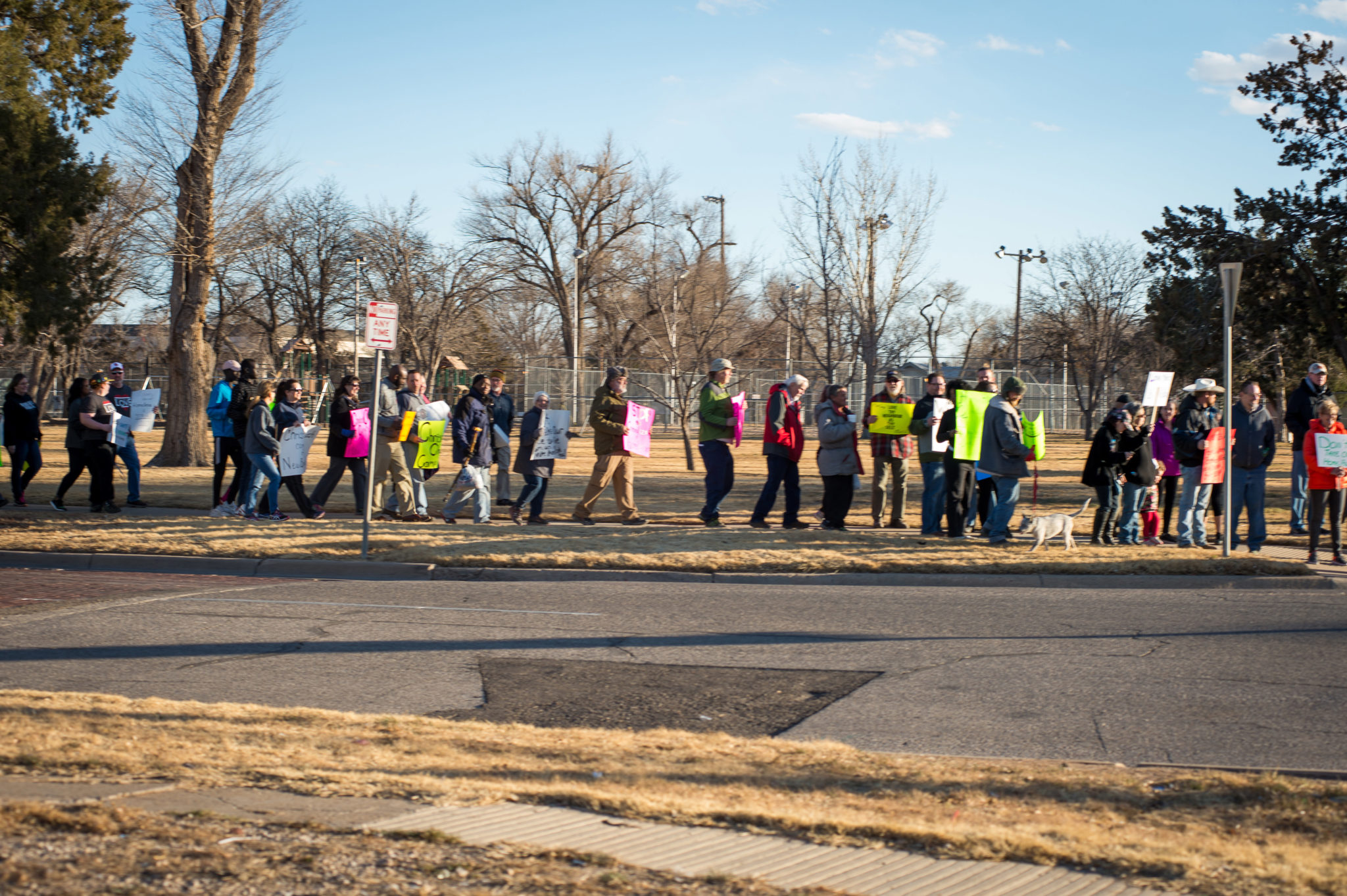
Marching from Ellwood Park behind a megaphone-wielding Brown-Hunter, they waved signs bearing messages like “IT IS ILLEGAL TO BE HOMELESS IN AMARILLO,” and along the way hypothesized about why the city had come down so hard on the camp. The leading theory is that the eyesore Tent City might clash with the $300 million downtown revitalization project that city officials have tried so hard to usher in. Starbuck, the assistant city manager, said that’s hogwash. “There’s no drive to move people out of an area,” he said.
The protesters weaved a path from the park down South Adams Street and back to the camp, drawing some horn-honking and thumbs-ups in solidarity from onlookers. Standing atop a log, Brown-Hunter gave an impassioned speech through the megaphone. But after everyone but the homeless walked back to their cars, and night began to fall, the campers started to hunker down for a cold night — the overnight low was 23 degrees. Moore broke thin strips of wood over his knee and chucked them into the fire pit.
“This is our home. If we didn’t have this, I don’t know where we’d be,” he said. “It’s really sad what the city is trying to do. Hope they make the right decision.”
Photos by Shaie Williams.



